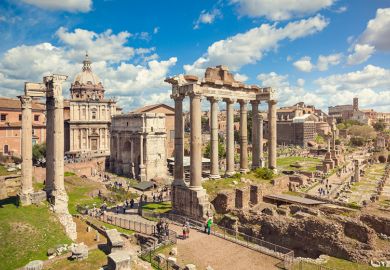In 2008, a medical bracelet belonging to James Brown sold for an astonishing $32,500 – more than a hundred times the original estimate. In selling off the Godfather of Soul’s shiny suits, awards and childhood photographs, the auctioneers capitalised on the desire of ordinary mortals to channel the remote world of celebrity. Although sales were otherwise disappointing, the bracelet, listing Brown’s name, allergies and diabetes, was a runaway hit. An item that had so closely testified to the great man’s body now provided the most powerful link to his soul.
I doubt that the three authors of The Sacred Home in Renaissance Italy submitted the anonymous winning bid, but they understand better than most how material objects can become portals to other realms. Their new book sets out to reconstruct devotional life in Renaissance Italy through its households and especially the items within them.
These objects infused their environment with sacrality. The Sacred Home is crammed full of bedrooms transformed into prayer corners, newborns bedecked with sacred amulets, devotional books worn on the body, Christ figurines kissed raw, household icons performing life-saving miracles. The amount of material in the book is astonishing. To compile and interpret it all, the authors have marshalled their expertise in three different, related disciplines: the literature, history and art history of Renaissance Italy. Their analysis ranges from oil paintings to wax tablets to furniture, but also relies on literary treatises, poetry and religious literature of all kinds, as well as wills, inventories, pawnshop registers, letters and trial records.
The book seeks to break new ground by avoiding the “golden triangle” of Venice, Florence and Rome that lures scholars over and over to the same archives. Instead, the authors look primarily at three areas much less familiar to anglophone scholars: the prosperous and potentially heterodox towns of the Venetian terraferma, or mainland territories; the vulnerable but choosy inhabitants of the Marches on the Adriatic coast; and the vibrant, pious, contradictory city of Naples, too often ignored by scholars of Italy, but in fact the largest city in western Europe at the time. Brundin, Howard and Laven consciously seek to compensate for long-standing blind spots in Italian Renaissance scholarship. They investigate rural as well as urban areas, indigents as well as elites, local artists from foreign backgrounds, men as well as women (especially important in a book about domestic life). They also offer a robust defence of the maligned term “Renaissance”, often replaced by the blander “Early Modern Period”. Here, the term is meant to remind us not to impose stark retroactive divisions on pre- and post-Reformation Europe, and to counter stereotypes of the Renaissance era as secular and elitist. To the authors, the Renaissance was also the age of miracles, and the beating heart of Renaissance religion was the home, not the church.
The great power of material objects lies in their capacity to encompass multiple uses and meanings, to cross boundaries, to embrace contradictions. The book shines most when it draws these out. It gazes with us at a nativity painting, guiding us through the rhetorical, mental and visual journey it constructs, and conjuring the varied associations it could offer to different Renaissance viewers. Two editions of the anonymous medieval Meditations on the Life of Christ reveal many ways of reading or absorbing the same text, including emulation, annotation, meditation or inattention. Pawn-shop registers list wolf’s-tooth amulets alongside tiny crosses; a trousseau might register rosaries together with bracelets; coral acted simultaneously as jewellery, lucky amulet and symbol of Christ’s blood. Curtains on paintings, or curtains in paintings, echoed all the ways domestic space was rearranged for more or less sacred uses. Ex voto tablets, painted as thanks for miracles granted, show how domestic cares intruded into church life more than the reverse. By describing and celebrating such juxtapositions, the book breaks down sharp oppositions between religion and superstition, devotion and decoration, beauty and piety, religious and secular spheres. Such distinctions, the authors suggest, are impositions of the Counter-Reformation or modern eras, alien to the original times.
For all their attention to detail, the authors don’t skimp on theoretical rigour. A wooden rosary’s ability to link memory, tactility, orality and devotion; the many nuanced ways of reading, hearing, touching, wearing or owning written texts; the theological and conceptual work necessary for venerating the cloth relic known as the Veronica , which bears Christ’s features – all these receive thorough and sensitive explanations. The bravura chapter on “The Devotional Eye” unpicks the many layers of meaning that connect the value, potency and ingredients of objects, their levels of reality and illusion, the controversial religious properties of three-dimensional images, the interplay between text and image, and human attempts to capture the transcendent. We come away fully aware of the devotional energy of each object described, interwoven within a sensory landscape of sound, touch and smell.
It’s clear from the book that Renaissance Italy witnessed an explosion of both material production and religious devotion. The sheer number of items available for sale and production skyrocketed and, in an era of agonising religious strife, so did the appetite for them.
Much of the devotion enacted at home is foreign to us. Our doorways don’t bear religious inscriptions; our homes don’t contain basins of holy water, tailored covers for shielding the Virgin Mary when we’re up to no good or pietre sacre – consecrated slabs to enable temporary at-home altars. At the same time, much of what the book describes feels almost familiar to the modern reader. Indeed, the authors know well that their description of Italian homes as nostalgic, contradictory, intimate and subject to sensory stimulations has universal resonance. I found myself wondering which aspects of Renaissance domestic devotion were most specific to the era. Our lives today are flooded with throwaway or priceless items. And if we were as uniformly devout as the Renaissance Italians in this book, would we still treat our own devotional objects in the ways that they did?
To that end, I asked some of my peers about the religious objects in their homes. The results surprised me; they said a lot about the persistence of religion, but also about its new hybridity. One person mentioned her prized Orthodox icon, received from a secular friend during a study-abroad in Russia. One Roman Catholic couple collects crosses, but inherited Hindu deities from grandparents and received more as family wedding gifts. One lights grandma’s shabbat candlesticks weekly within sight of her beloved statue of Buddha. A rabbinical student recalled her Catholic mother’s revered statue of John the Baptist. As in Renaissance Italy, respect for religious and ancestral objects in the home remains strong. But even the most pious households I surveyed owned and cherished objects from other faiths. Today, the number of faiths that now touches each household has expanded, and with it the range of paraphernalia. It’s possible, even likely, that our ability to embrace objects from outside our traditions stems from a diluted confidence about what we think such items can accomplish. In Renaissance Italy, however, certainty in the power of religious homes and possessions was strong. Where our houses only contain religious objects, their houses were.
Emily Michelson is senior lecturer in history at the University of St Andrews.
The Sacred Home in Renaissance Italy
By Abigail Brundin, Deborah Howard and Mary Laven
Oxford University Press
400pp, £35.00
ISBN 9780198816553
Published 19 July 2018
The authors
Abigail Brundin is a lecturer in the department of Italian at the University of Cambridge. Her research on Renaissance and early modern Italy takes in the visual arts, history, political theory and religion as well as literature. She has written extensively on Vittoria Colonna and other female writers from the first age of print. She has also collaborated with the National Trust in examining the Italian books in the libraries of English great houses.
Deborah Howard is professor emerita of architectural history at Cambridge; she has also taught at the Courtauld Institute of Art, University of London, the University of Edinburgh and UCL as well as on Yale University’s Summer Term Program in London. Much of her work has focused on the art and architecture of Venice and the Veneto, and her books include Sound and Space in Renaissance Venice: Architecture, Music, Acoustics (with Laura Moretti, 2009) and Venice Disputed: Marc’Antonio Barbaro and Venetian Architecture, 1550-1600 (2011).
Mary Laven is professor of early modern history at Cambridge. She studies the social and cultural history of early modern Italy and Europe, with a particular interest in religion, gender, sociability and material culture. Her first book, Virgins of Venice: Enclosed Lives and Broken Vows in the Renaissance Convent (2002), explored the experience of nuns during the Counter-Reformation. It was followed by Mission to China: Matteo Ricci and the Jesuit Encounter with the East (2011).
The three authors were the principal investigators on a project funded by the European Research Council titled “Domestic Devotions: The Place of Piety in the Renaissance Italian Household, 1400-1600”. Their findings also fed into a 2017 exhibition at Cambridge’s Fitzwilliam Museum, Madonnas and Miracles: The Holy Home in Renaissance Italy.
Matthew Reisz
POSTSCRIPT:
Print headline: The transportive power of objects
Register to continue
Why register?
- Registration is free and only takes a moment
- Once registered, you can read 3 articles a month
- Sign up for our newsletter
Subscribe
Or subscribe for unlimited access to:
- Unlimited access to news, views, insights & reviews
- Digital editions
- Digital access to THE’s university and college rankings analysis
Already registered or a current subscriber?






